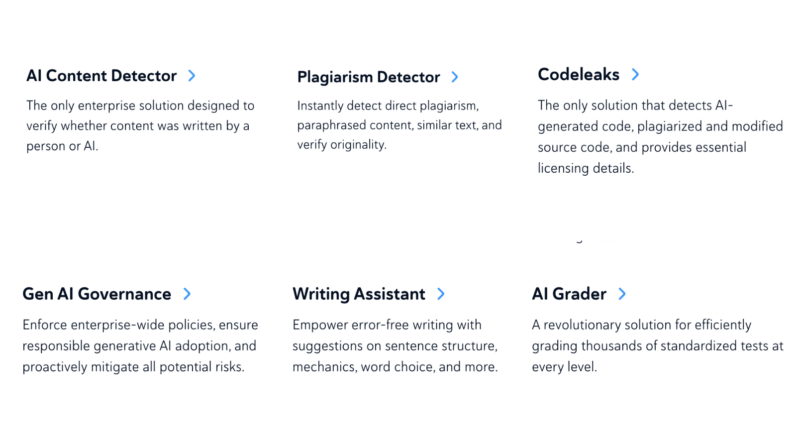There are plenty of reasons why people look for Skillshare alternatives on the market. As an online learner, you may just want a larger selection of in-depth, high-quality courses that correspond to your goals and interests.
The classes on Skillshare are interesting. But they are mainly for beginners and are usually only 30-40 minutes long.
Individual Skillshare classes are not available for you to buy. Like Netflix, the entire platform is based on a subscription business. I prefer to buy a course so I can download and view it lots of times in the future rather than pay a monthly membership price if I need to re-watch a section.
Skillshare seminars are mainly about design and entrepreneurship. If you need help with more advanced academic areas, you’ll have to look elsewhere.
Here’s a list of Skillshare alternatives that give you exciting and relevant options for both instructors and students.
Table of Contents
Skillshare is a virtual learning site with diverse disciplines and a wide range of online courses managed by specialists. This site is well known for assisting people in teaching and learning.
The online learning platform includes academic and practical skills taught in easy-to-follow courses. Free lessons, paid classes, shared learning, group classes, and high-quality learning resources are available in sectors such as the arts, technology, business, and science.
Skillshare courses are mostly in the form of videos. It’s a massive platform where students can interact and contact specialists and teachers.
Pros
- There is a 40% first-time member discount available.
- There are 2,145 classes available for free.
- A student discount of 50% is available.
- 30,000+ courses in a massive collection.
- There are almost 8,000 teachers in all.
- The newer courses are of excellent caliber.
Cons
- The majority of Skillshare courses are unaccredited.
- There are no college degree programs available.
- Employers do not accept Skillshare certificates.
- Other services, such as Coursera, offer free equivalent courses.
- Some of the courses are of poor quality.
- Students only have access to the course material while they are paying for it. Once payment stops, access to the material is blocked.
As a Skillshare teacher, you will be paid royalties depending on the number of paid minutes your students watch in your lessons. But, Skillshare keeps 30% of all revenue generated on the site in a royalty pool dedicated exclusively to teachers. As a commission, the platform keeps 70% of every sale they make.
Each teacher’s part of paid minutes gets used to calculate instructor revenue. So, if your stake is 1% of the total paid minutes on the platform, you’ll be paid 5% of the royalty pool.
However, you are not compensated for the time spent watching free classes or course previews. To qualify for a particular month’s payment, you must have at least 75 paid minutes.
What Defines a Successful Online Course?
Life-changing material features you can style as you like, and flourishing course communities. These are the characteristics of successful online courses.
The route to mastering any talent is an important part of the process. The best Skillshare alternatives provide members with education in the form of lessons that are easy to absorb. They also establish a path for them to follow.
For course creators, your online course should provide a path for students to change their lives. And then they should get measurable outcomes at the end. To do so, you’ll need a platform that allows you to build your course while nurturing your online community.
From a course instructor’s point of view: You can’t expand your network beyond the Skillshare platform. You don’t have access to your course members’ emails or personal information because you don’t run your own online course.
This means that Skillshare’s success, not yours, determines the growth of your community.
You should get paid whether you have one or 1,000 members. So, in this article, we’ll look at 17 Skillshare alternatives that will help you increase both income and your course community.
And for students, in case you’re looking for something different, our list will give you some alternatives to Skillshare.
Podia
Podia is a platform for digital entrepreneurs that offers online courses, memberships, and digital products. Their program is designed to assist businesses in marketing their products, creating digital shops, and more.
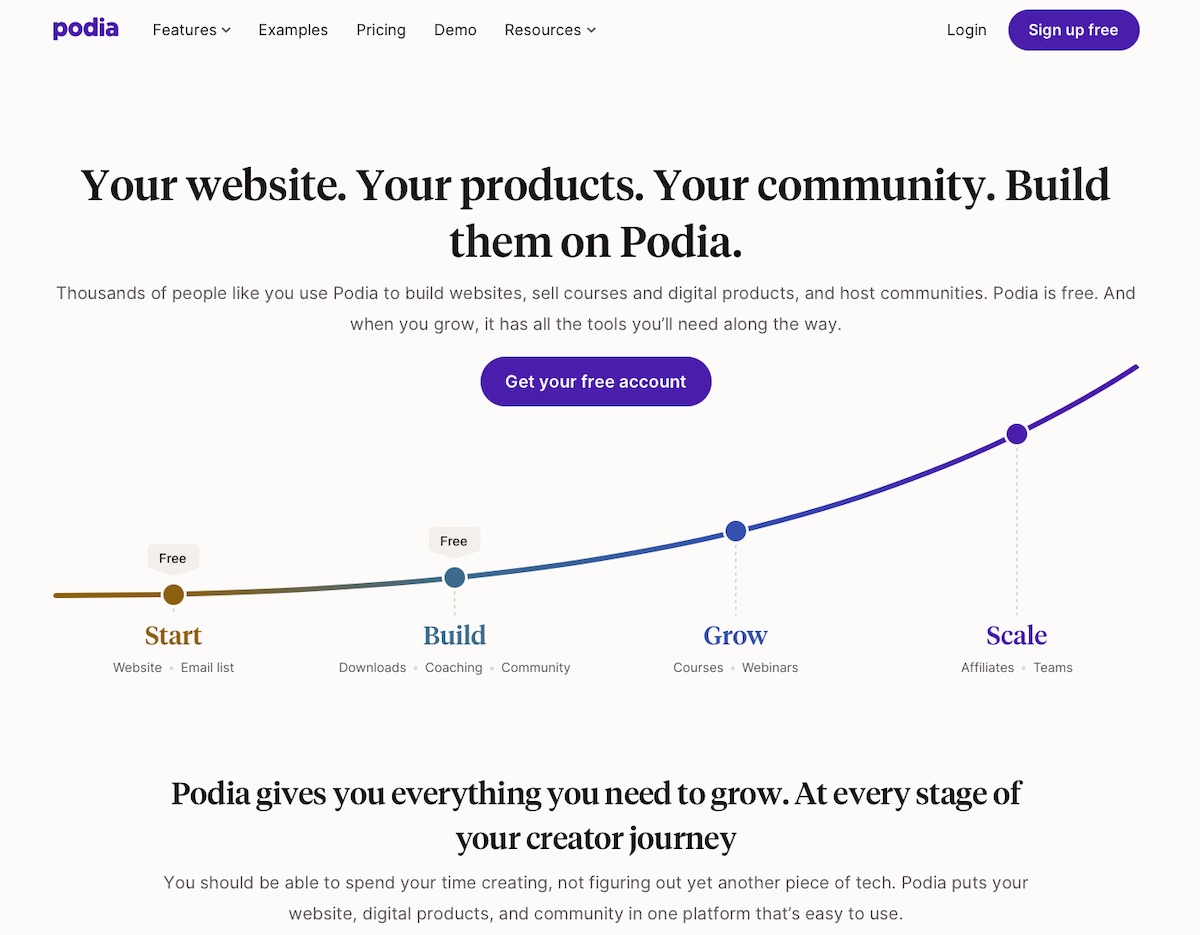
You can build online courses and provide digital memberships, one-time webinars, and digital downloads. You can also construct your own bespoke website, use email marketing tools, and get help 24 hours a day, seven days a week. It’s a platform with practically all the tools educators need to build and launch a successful course.
While Podia holds online courses, its structure is less recognizable to traditional educational formats than other platforms on the market. Podia has many fantastic features, but its platform primarily relies on integrations.
Some significant areas where this could be a concern include analytics, which will require you to connect to your Podia products through a third-party provider.
Podia Pros and Cons
Pros
- Payouts are instant, so you never have to wait.
- The platform is very user-friendly and reasonably priced for its capabilities.
- The user interface (UI) and user experience (UX) are both sophisticated and simple.
- Podia provides excellent customer service to all of its clients.
- Integrated Email marketing.
- Keep track of your student’s progress.
- You can host free or paid courses.
- Bandwidth is limitless.
Cons
- There is no free plan like Thinkific’s or Teachable.
- Personalization fields are missing from their email composer.
Get Your Podia Course Here
Coursera
Coursera is an eLearning platform that worked with major colleges such as Stanford, Yale, and Princeton. And they created one of the best learning experiences in short, digestible learning modules.
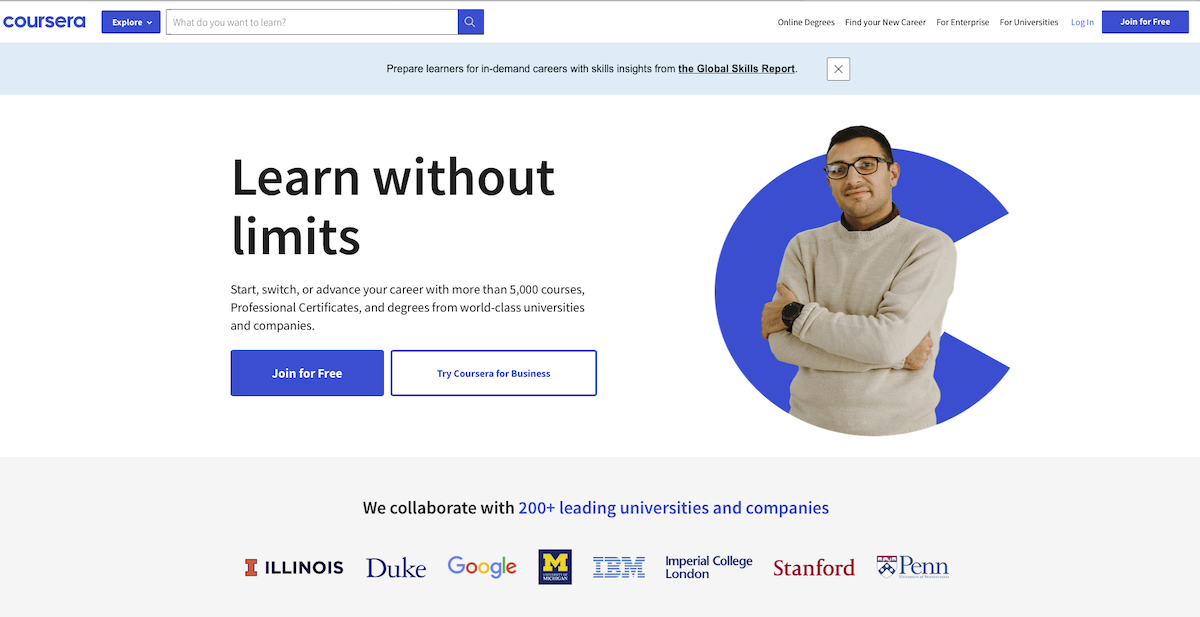
This site is also noted for its professional teaching capability and industrial-level excellence. You may get a real degree by enrolling in Coursera’s handpicked programs. (The degree program cost can range from $10,000 to $25,000.)
You also have lifetime access to specialize in various courses and degrees. There are 827 beginners, 619 mixed-level, 322 intermediate, and 34 advanced courses available on Coursera.
Coursera’s payment strategy is interesting. Instructors don’t get paid but instead get stock in the company. With vested interests, instructors have financial incentives to stay engaged.
They also make money on training materials and get a cut of the revenue from certification exams.
Coursera Pros and Cons
Pros
- You can earn a real degree.
- You also get completion certificates.
- Financial aid is available.
- Beginner-friendly, flexible learning courses.
- Practice tests and access to useful resources.
- Entry-level classes that last 4 to 12 hours are free.
Cons
- Degrees that last 2-4 years start at $9,000.
- Tuition ranges are also listed on degrees, and users pay to complete each module.
- Users with a prior understanding of the subject may need to take “beginner” level courses.
- Instructors run through information and vocabulary pretty fast. This can be difficult for students who are new to a subject.
Khan Academy
Khan Academy is a non-profit organization that provides free education to people of all ages. It’s a community of programmers, teachers, designers, scientists, and content experts who want to help others learn.
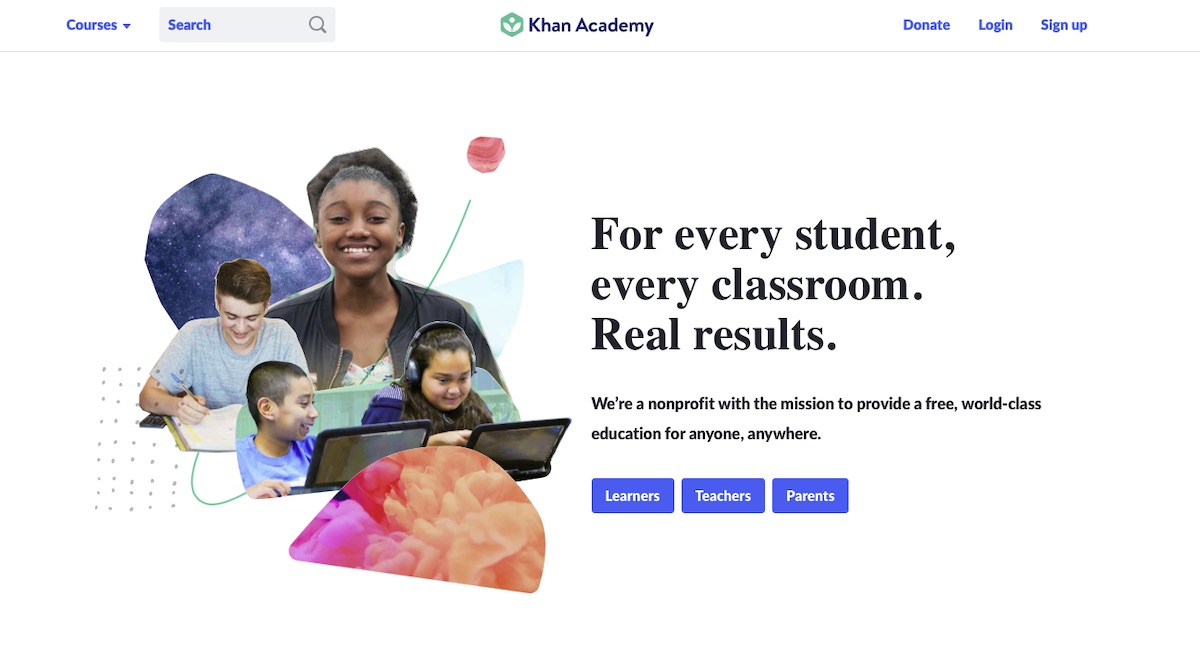
Khan Academy wants to make education more accessible to all children and individuals who wish to study. The courses include short videos, practice exercises, and teaching tools.
You can learn about various topics and subjects for free. These include mathematics, art, history, science, economics, and exam preparation, without intrusive commercials or other distractions.
Khan Academy Pros and Cons
Pros
- Khan Academy is both free and open to the public.
- There are numerous subjects to choose from.
- You have the freedom to learn and work at your own speed.
- It has an enormous number of arithmetic problems for a range of grade levels (from very basic elementary concepts to calculus).
- Teaching tools are great.
Cons
- It is less participatory than having an instructor or tutor in person.
- You get exposed to only one type of instruction.
- The collaborative part of education is lost.
Thinkific
Coaches, specialists, and managers can use Thinkific’s eLearning platform to develop and disseminate their lessons. This leading training portal includes everything you’ll need to get started and attract people to sign up for your courses.
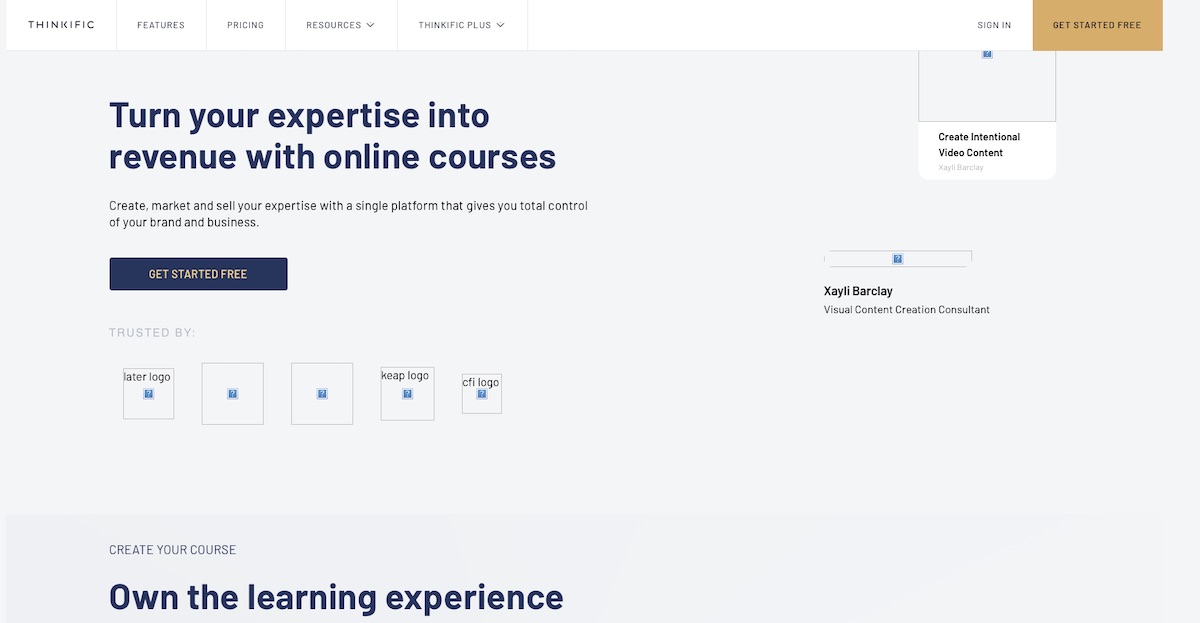
Thinkific, like Skillshare, allows you to use quizzes and surveys to assess your learners’ comprehension. You can quickly create your own training material using their drag-and-drop editor. And to enhance the learning experience and courseware, you may also integrate various photos, videos, extra papers, imports, and embeds.
Thinkific Pros and Cons
Pros
- Good platform for creating course content.
- Versatile and customized tools allow you to construct your course exactly how you want it.
Cons
- Needs strong community-building tools.
- Poor community administration and development.
- A lack of live events, Q&As, in-person coaching, and other big event-based learning opportunities significantly limit your online course’s expansion.
- Most creators soon outgrow the platforms’ limited features.
Udemy
Udemy’s courses, like Skillshare, do not have any accreditation and solely assist an individual in personal and professional development. These courses will not get you college credits, but they will provide you with a wealth of information about plenty of subjects.
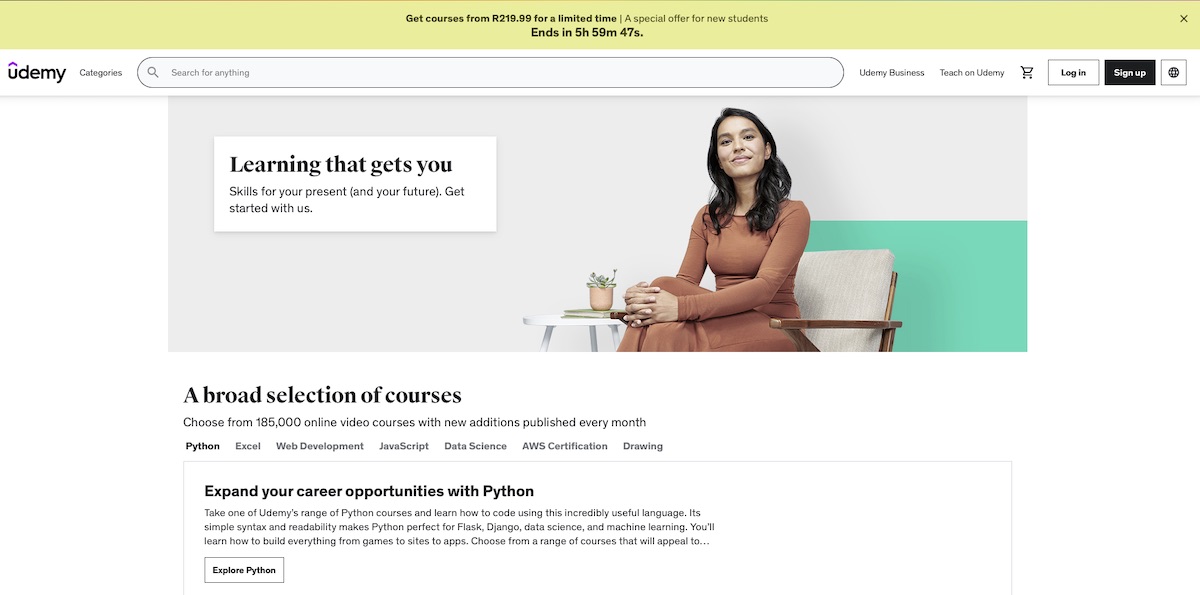
But if you are interested in creating a course then read how to make a great Udemy course that makes money. And you will also want to know – how much money do Udemy instructors make?
Udemy Pros and Cons
Pros
- Very popular.
- It has a big marketplace, which attracts a significant number of potential clients.
- Easy-to-use navigation and rating system allow your supporters to raise your visibility on the platform.
- Udemy enables creators and entrepreneurs to create various materials, including video, text, audio courses, quizzes, Q&As, and more.
Cons
- Udemy promotes first-to-market courses no matter their educational quality. This puts students and course creators at a disadvantage because better courses can be overlooked or relegated to pages too far in the indexes for many students to bother looking for.
EdX
If you want to take classes from reputable and well-known educational institutions, EdX is a good place to start. You can find high-quality, in-demand courses from Harvard, MIT, Berkeley, Google, Microsoft, other universities, and partner firms.
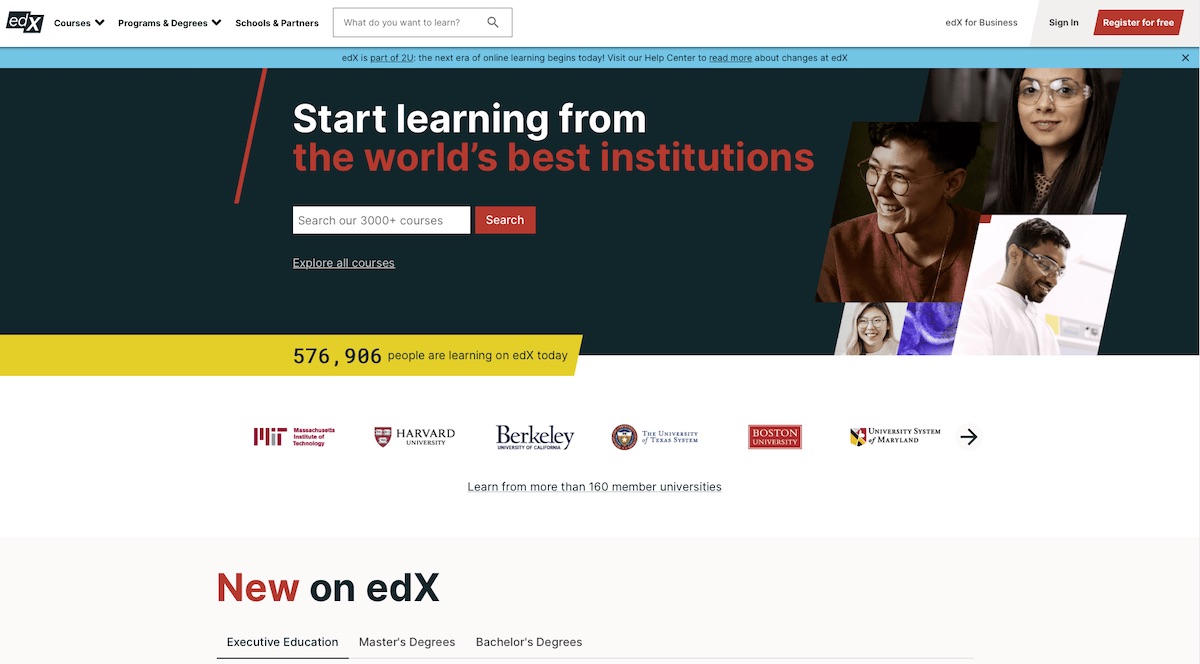
Their course catalog is available in up to 11 different languages. It covers many themes and learning solutions in job-relevant subject areas. Including computer science, engineering, and business, to name a few. And instructors can use assessments to determine their students’ current level of competency in the courses.
EdX Pros and Cons
Pros
- You can learn at your own pace.
- Save courses to your computer and use them offline.
- On completion, you will receive an accredited certificate.
- There is a fantastic 14-day refund policy.
- The classes are taught by genuine professionals from reputable colleges.
Cons
- In the specialized courses, the format is inconsistent.
- Instructors do not get compensated for their time and expertise (although it seems that this may change soon).
Brightspace
Brightspace (also called D2L) is a cloud-based learning management system that helps K-12 institutions, corporate firms, and higher education institutions deliver hybrid and entirely online courses.
This platform consists of three integrated systems: Learning environment, Learning Object Repository, and ePortfolio.

The Learning Object Repository (LOR) is an online library. It’s used for storing, managing, and sharing your learning resources (learning objects).
Brightspace Learning Environment is a cutting-edge learning management system that allows you to create, host, and update online learning materials. It comes with a versatile set of tools for customizing content for institutions, courses, and users.
Learners can share their experiences with classmates and mentors on the Brightspace ePortfolio. This is a common platform.
Brightspace Pros and Cons
Pros
- Records the lectures.
- The online classroom allows for screen sharing and chatting.
- Cleaner, easier to use platform than, for example, Google Class.
- Great and accessible customer service.
- Excellent resources for teachers.
Cons
- Provides many locations where you can find the same information. This is particularly perplexing when certain assignments are loaded in a course module but not on the ‘Assignments’ page, or vice versa.
- Has more case-by-case/glitching issues than other learning management systems.
Gumroad
Gumroad is a marketplace for digital products (ebooks, music, and software), plus some support for selling physical goods.
Read more about it in our Gumroad review.

While the Gumroad website offers a “Gumroad for Courses” sales page, the site is primarily used to provide downloads, so there is no way to design and deliver a live course with any form of interactivity. You can make a course out of videos and PDFs that you can sell as downloads.
The platform collects email addresses. Plus, it allows you to manage email marketing from within the software or download emails for later use.
This is a powerful service for downloadable products like ebooks, music, and stand-alone videos. It enables creators to plan the ongoing marketing of their courses.
For course creators, Gumroad is good as long as you provide all the necessary tax information and are okay with your payments taking time to get to you.
Gumroad Pros and Cons
Pros
- You can customize checkout pages and widgets.
- Support for subscriptions and memberships.
- Payments via PayPal and credit card are accepted.
- Create coupons and discounts with ease.
- Easy-to-use interface with built-in affiliate center.
- Affordability.
Cons
- There is no A/B testing or advanced analytics available.
- No method to provide free trials.
- The knowledge base is limited.
- Customer service is not great.
- No way to market services.
- Integrations are limited.
EdApp
EdApp ensures that your corporate learning experience is engaging. It uses a gamified microlearning approach to create its learning courses to boost retention and convenience. Rather than just watching videos or reading digital learning materials, EdApp makes learning fun.
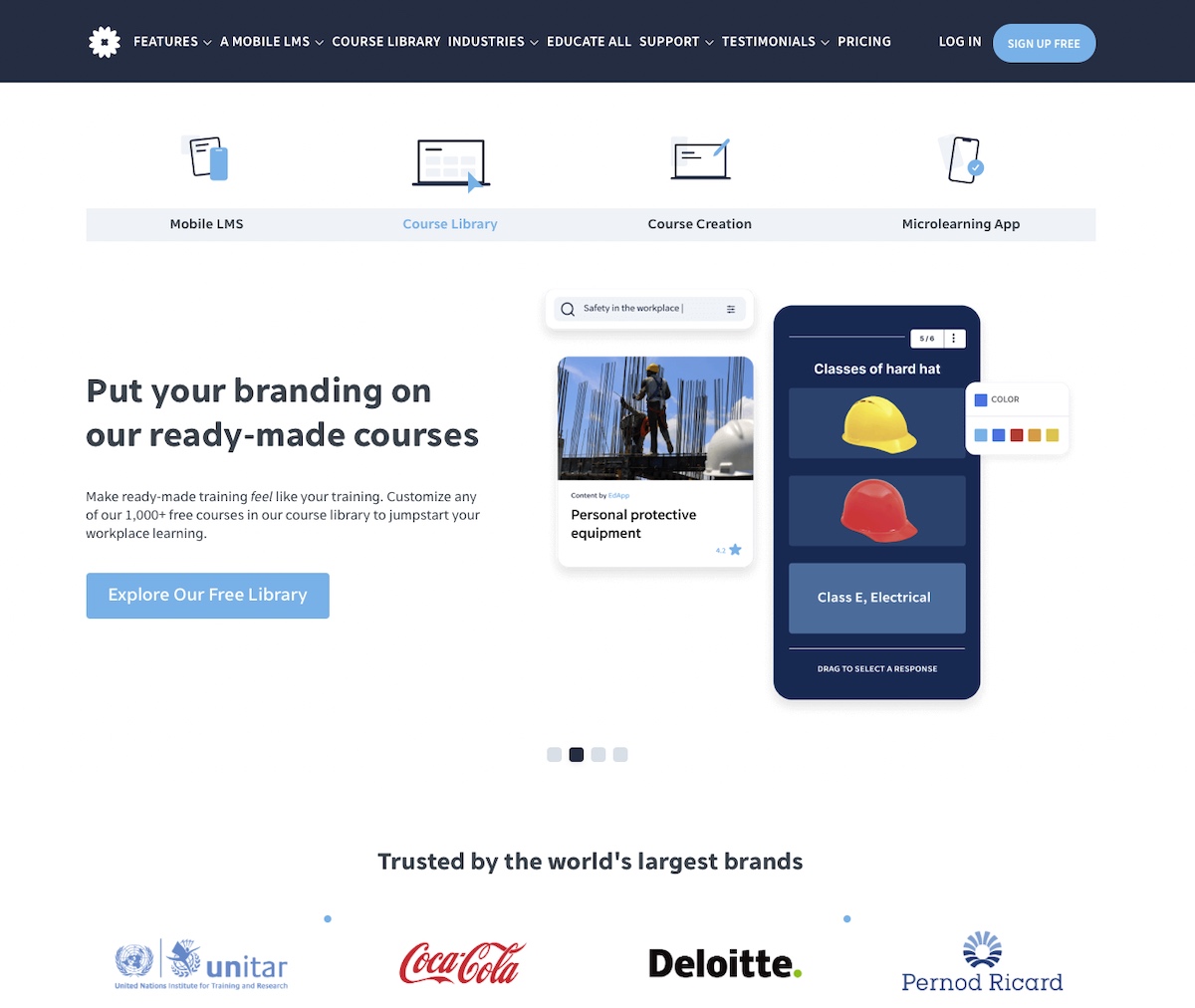
Microlearning and gamification combine to offer information in short-form lessons with gaming features. This keeps you actively involved throughout the learning process.
Because the lessons are in a condensed format, they may be done in a matter of minutes. This enables the instructors to provide engaging and interactive online instruction.
Around 80 intuitively designed microlearning templates are available in the template collection. All are suitable for various learning approaches.
EdApp Pros and Cons
Pros
- Learners can access a course library that includes over 800 mobile-friendly courses.
- Some systems include survey slides that allow you to provide feedback on the course and its lessons which is useful for instructors.
- EdApp offers AI translation in over a hundred languages.
Cons
- *Scorm is the only way to download or archive a course or lesson.
- The content slides have a few issues, especially when using an Android device.
- Some of the templates have limitations.
- A few platform functions are restricted. You can’t, for example, duplicate an assignment or change the achievements.
- And for teachers, it isn’t easy to keep track of students as they finish modules.
*Scorm = Sharable Content Object Reference Model. It is a set of technical standards for eLearning products. These are the communication channels and data models necessary for eLearning material and LMSs (Learning Management Systems) to work with each other.
Kajabi
Kajabi is a wonderful Skillshare option for companies wanting business and marketing features. Here transforming experiences are not required.
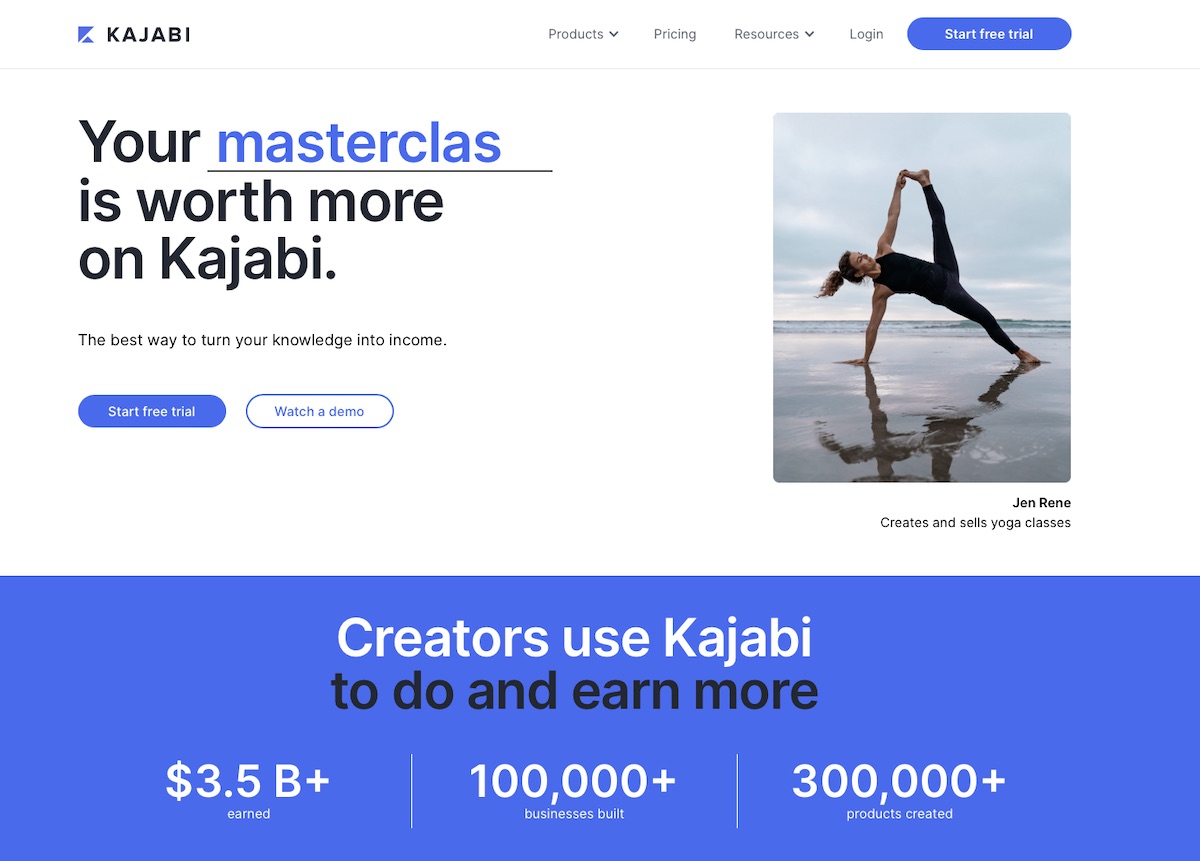
“If you can envision it, you can monetize it,” their tagline says, and they follow through on their promises. But, creating an online course should entail more than just collecting money from your students.
The top online teaching platforms stress the necessity of creating a community. This will help you develop your network and brand value.
Kajabi Pros and Cons
Pros
- Tools available include online subscriptions, gated content, and membership sites.
- You can control how and when your subscribers receive content from your online course.
Cons
- Extremely costly.
- Limitations on how many members you can have.
- Restrictions on support options if something goes wrong.
- The community options are also lacking, especially given the price.
- The amount of privacy available for gated content is limited. Members have either full access or none at all.
LinkedIn Learning
Most people are familiar with LinkedIn, the online professional networking site founded in 2002. It boasts a remarkable 774 million members.
But, LinkedIn has a subsidiary, LinkedIn Learning, that focuses on online learning (previously known as Lynda.com). There are over 16,000 courses available, concentrating on “in-demand skills.” 78% of the Fortune 100 companies use LinkedIn Learning to train their teams.

The LinkedIn Learning platform is a good recommendation for folks wanting to develop their professional abilities and increase their work opportunities.
On average, instructors at LinkedIn Learning may expect to earn $51 per hour. The base rate is estimated to be $36. Cash bonuses, commissions, tips, and profit-sharing could be options for further compensation.
LinkedIn Learning Pros and Cons
Pros
- Excellent for learning certain hard skills, such as software.
- High-quality production.
- One-month free trial.
- Annual savings option.
- Nice content previews.
- Completion certificates are available.
- Smartphone apps to learn anywhere.
Cons
- Support choices are limited.
- Single-tiered strategy.
- The cost is quite high.
- Limited content options.
- The classification of classes is a bit confusing.
MasterClass
MasterClass isn’t your average Skillshare competitor. You’ll find over 100 online classes offered by renowned and well-known specialists and celebrities here.
Learners can enroll in various courses, such as Gordon Ramsay’s course on making restaurant-quality food. Diane von Furstenberg offers a course on building a brand, and Marc Jacobs teaches how to develop your own fashion line.
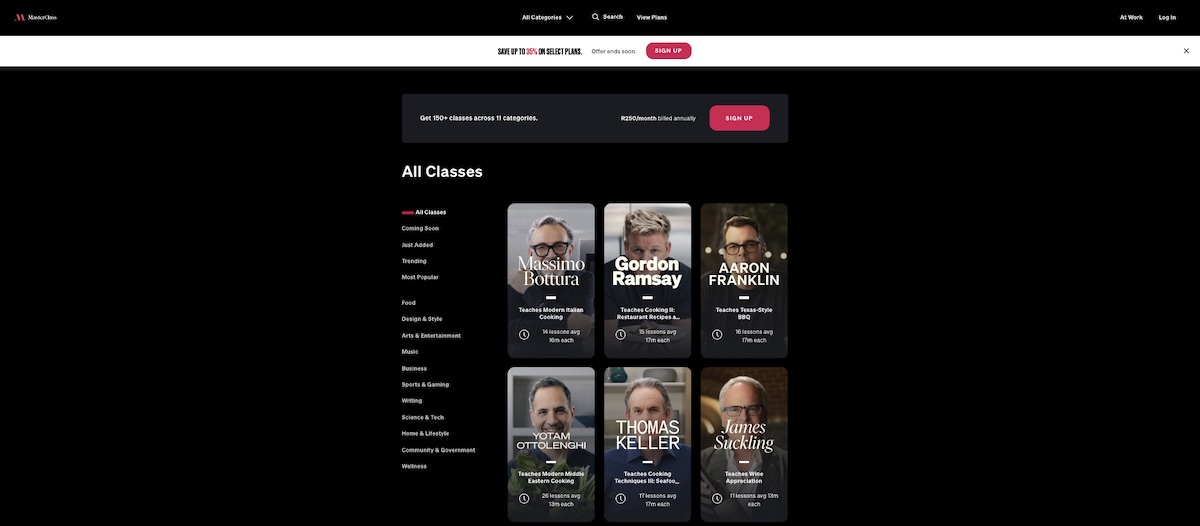
Each course has 15-20 well-produced and interesting videos, most of which are 10 minutes long and accessible offline. With their mobile app, your learners can take these sessions anytime and anywhere. This is great for a self-paced learning experience.
Most of these courses are geared toward beginners, so if you’re a seasoned pro, these video courses might not be worth your time or money.
MasterClass Pros and Cons
Pros
- Students get expert instruction.
Cons
- Limited number of specialist course selections. This is because they only invite the brightest minds worldwide to discuss certain themes.
- Most of these courses are geared toward beginners, so if you’re an experienced pro, these video courses might not be worth your time or money.
Mighty Networks
Mighty Networks heralds a new era for independent producers looking to take control of their audience and content. On the web, iOS, and Android, creators and businesses can build vibrant communities, natively broadcast, charge for memberships, and provide courses all in one place.
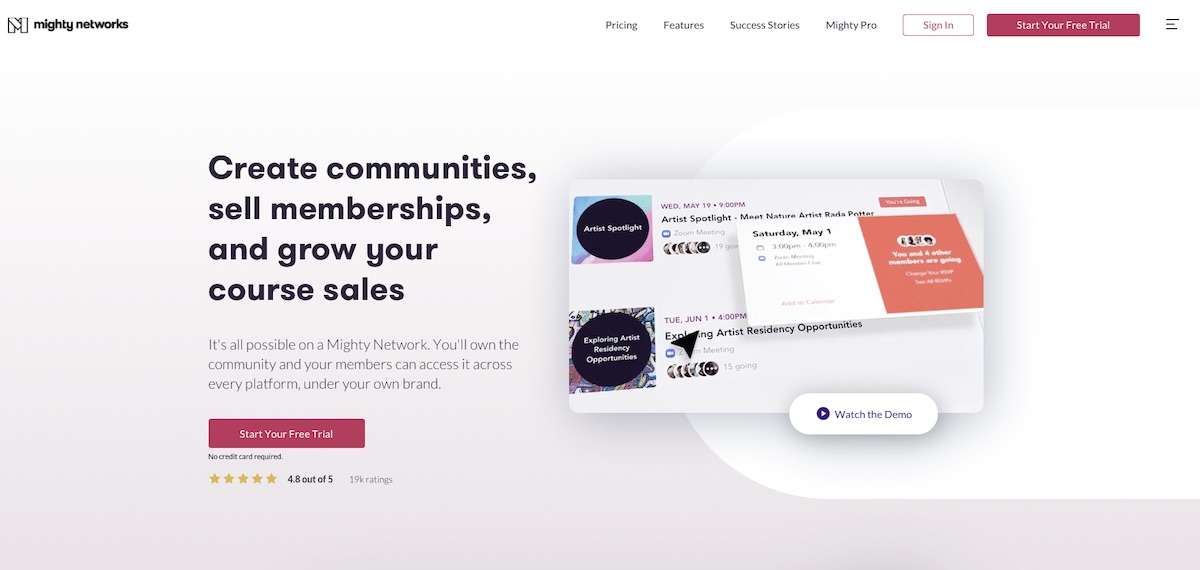
The site allows content developers to create premium online courses. You can then sell those courses alone or as an extra benefit to your community membership.
Mighty Networks is a terrific alternative to Skillshare since it allows you to establish a website, online courses, communities, VIP groups, and more from several perspectives.
Mighty Networks Pros and Cons
Pros
- User-Friendly Interface.
- User-Friendly Designs: Everything is simple to use for both students and course creators.
- You can send out Student and Member Notifications to contact your students.
Cons
- Payment Issues: PayPal isn’t supported, and Cash App isn’t accepted.
- No course integration with other platforms: Porting from another LMS can be very difficult.
- No Quizzes: Seeing if your students remember previous lectures is one of the finest ways to test them along the way.
Mindflash
Mindflash (rebranded as Trakstar Learn) is a learning management system for the extended enterprise. (The concept that a business can’t succeed unless it has a network of partners.)
Large and fast-growing companies regularly train thousands of contractors and channel partners on business-critical topics. Including content production, business analytics, program administration, and enterprise integration. Mindflash is also cloud-based.
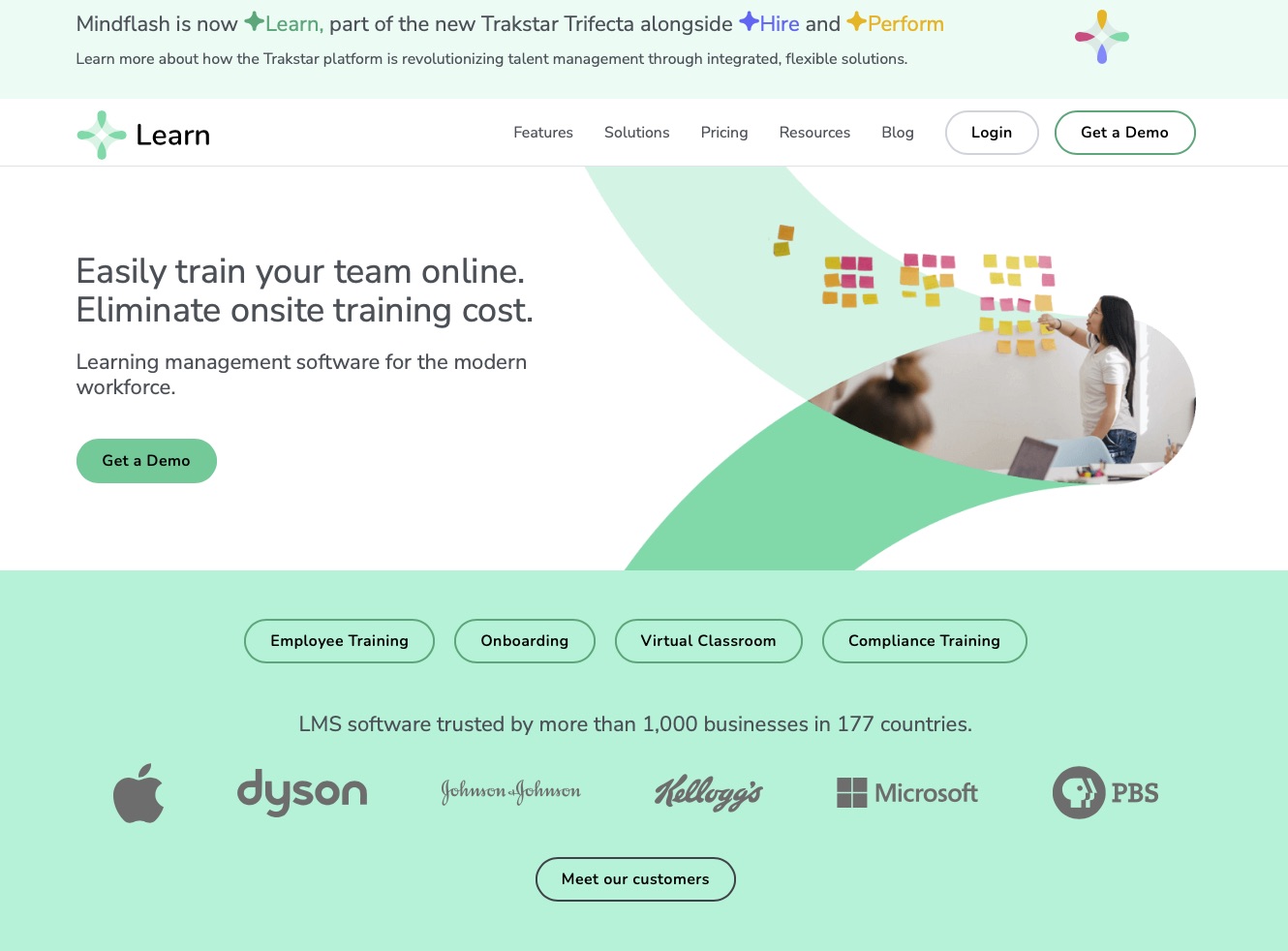
Mindflash Pros and Cons
Pros
- Course creation and deployment are simple and easy.
- Audio and video recording in the app.
Cons
- No live classes.
- Expensive.
- The maximum file size is 350MB.
- No gamification.
Pluralsight
Pluralsight (formerly called Code School) is a tech-based learning platform designed specifically for creative professionals who may benefit from IT Operations, Cybersecurity, and Web Development courses.
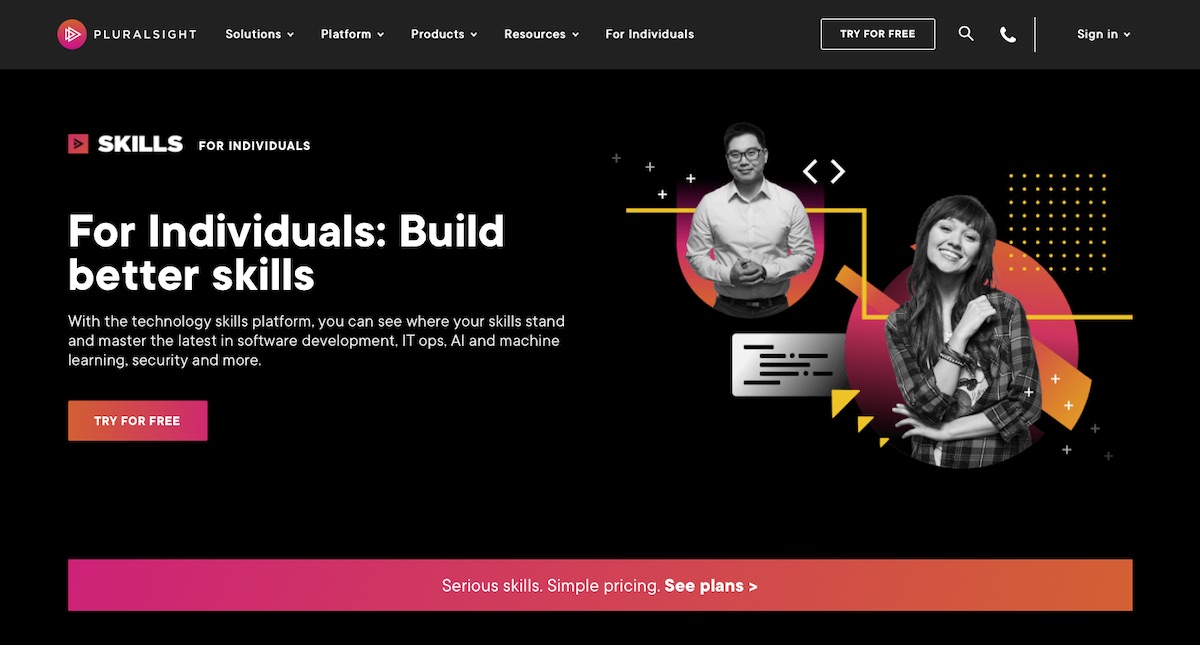
This site provides one of the best learning experiences with pre-configured cloud stations and learning routes.
Pluralsight Pros and Cons
Pros
- Hands-on learning.
- Certificate on completion.
- Beginner-friendly.
- Skill assessments.
- Many in-demand courses.
Cons
- It is mostly concerned with the field of information technology.
- For beginners, the level of the courses is tough to comprehend.
- The platform is only for persons who have a lot of experience.
- Some of the courses are no longer relevant.
SuccessValley
SuccessValley is an online Network Community dedicated to offering selected information on establishing a business to students and aspiring entrepreneurs.
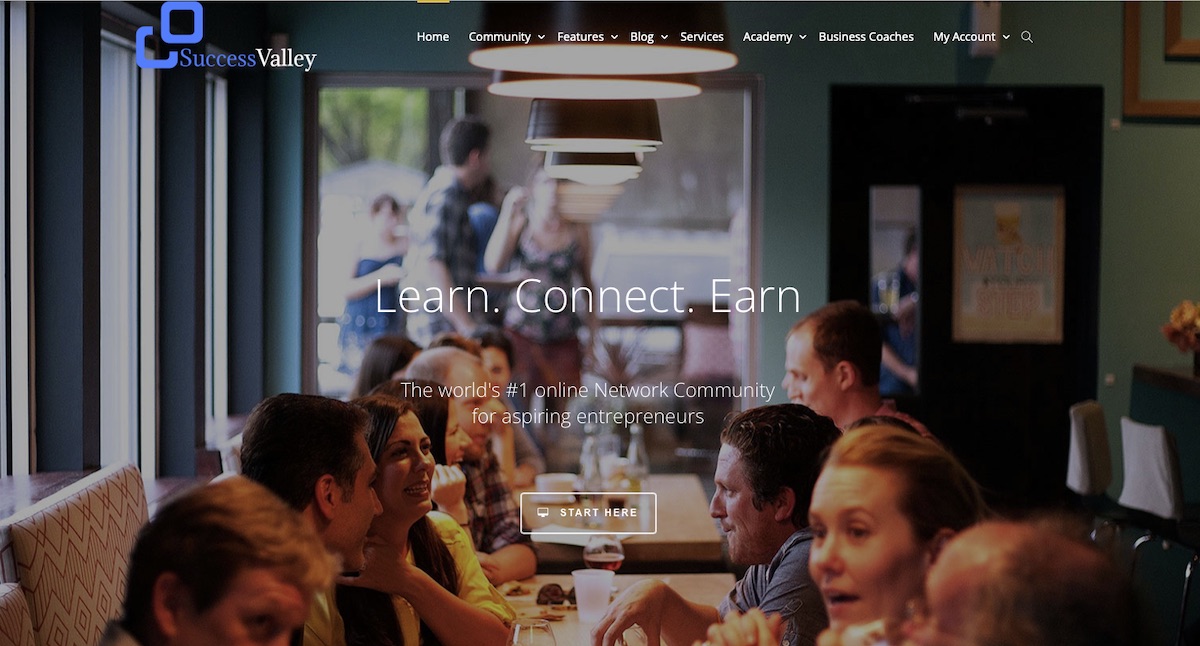
It aims to establish and maintain a Network Community for students and entrepreneurs to learn about the newest resources and development tools while networking to form good, growth-oriented relationships.
Very little is written about the Ghana-based (Africa) SuccessValley. But the few available reviews are pretty good. It may be worth checking them out.
SuccessValley Pros and Cons
Pros
- This website provides payment options that are “get your money back” friendly.
- Positive feedback on this website.
- The SSL certificate is in good standing (source: Xolphin SSL Check).
Cons
- The webpage is outdated.
- Website hosted in a high-risk nation.
- The registrar contains a lot of spammers and fraud sites.
TalentLMS
If you want to simplify the techniques of dealing with eLearning courses, online seminars, or training material, try TalentLMS. This application aids in the design and creation of eLearning courses pretty fast.
The course-building capabilities in TalentLMS are extremely powerful. These tools are exceedingly adaptable to your eLearning program’s needs.
This provides TalentLMS a competitive advantage over its rivals. This tool’s gamification capabilities make training more interesting and learning paths more stimulating.
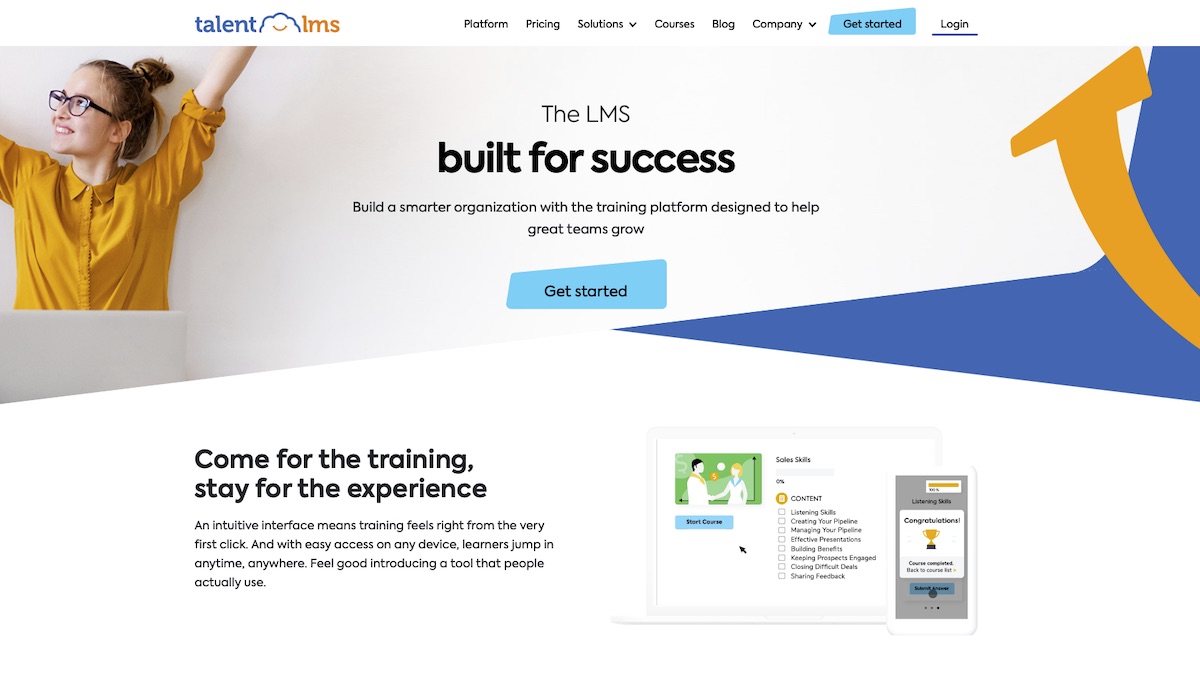
TalentLMS can handle both TinCan (xAPI) and SCORM, as well as CMI5 packaging. Ideal uses for this platform include blended learning, mobile learning, and sales training. It enables you to create an infinite number of courses and branches. It also supports a wide range of languages, which is advantageous for a larger organization.
The content is delivered using Amazon CloudFront and allows training managers to provide continuous employee training.
TalentLMS Pros and Cons
Pros
- The user interface is simple and customizable.
- The technology makes creating courses in many categories simple.
- It allows you to quickly and easily implement your learning model around the globe.
- Instructors can make their knowledge management process more efficient.
- The program includes step-by-step directions for creating quizzes and assessments.
Cons
- No chat capability.
- Few course setup options and content variety.
- The discussion forum may be improved to allow learners to network through forums, comments, and discussions.
Here’s a quick recap on the best Skillshare alternatives we could find:
- Podia – one of the best Skillshare alternatives for courses and digital products.
- Coursera – one of the finest Skillshare alternatives for all subjects, and degree courses are available.
- Khan Academy – best free courses.
- Thinkific – One of the top Skillshare alternatives for coaches, specialists, and managers to develop and disseminate their lessons.
- Udemy – among the best Skillshare alternatives for selling multiple courses at once.
- EdX – one of the Skillshare alternatives that offer high-quality, in-demand courses from Harvard, MIT, Berkeley, Google, Microsoft, other universities, and partner firms.
- Brightspace – (also known as D2L) is a cloud-based learning management system.
- EdApp – uses a gamified microlearning approach to create its learning courses to boost retention.
- Gumroad – marketplace for digital products (eBooks, music, and software).
- Kajabi – focused on business and marketing.
- LinkedIn Learning – 78% of the Fortune 100 companies use LinkedIn Learning to train their teams.
- MasterClass – best of the Skillshare alternatives for specialists learning with celebrities.
- Mighty Networks – best for “All-in-One” courses and community platform.
- Mindflash – (rebranded as Trakstar Learn) is a learning management system for the extended enterprise.
- Pluralsight – tech-based learning platform for IT Operations, Cybersecurity, and Web Development courses.
- SuccessValley – online Network Community for aspiring entrepreneurs.
- TalentLMS – aids in the fast design and creation of eLearning courses.
Finding a good Learning Management System can be difficult. When you’re looking for the best Skillshare alternatives, consider the following factors: features, price, customer service, quality, supported mobile devices, and integrations.
If you spend enough time investigating the options, you can find an online learning platform with all the features you need at a reasonable price.


